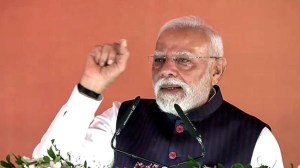Pentagon team on way for missile defence briefing
In a significant breakthrough for missile defence and more than two years after New Delhi made its first request, a Pentagon team will be la...

In a significant breakthrough for missile defence and more than two years after New Delhi made its first request, a Pentagon team will be landing in the Capital this Sunday to make a technical presentation on the Patriot Advanced Capability-2 anti-ballistic missile system.
Defence Ministry sources confirmed that a four-member team, led by Edward Ross of the Defence Security Cooperation Agency (DSCA), will be here from February 20 to 24 to discuss missile defence.
The team will present a technical brief to the International Security division of the Ministry of External Affairs and Ministry of Defence. Ross is second in command to General Koffler at the DSCA in Pentagon.
Sources said that the Pentagon team will interact with officers of the Indian armed forces and the Defence Research and Development Organisation (DRDO) during their four-day stay.
It’s learnt that the Bush administration gave clearance for a classified technical presentation of PAC-2 system as part of the Next Step in Strategic Partnership (NSSP) agreement signed last year.
The first indication that Washington was willing to share technical data came after Indian Ambassador to US, Ronnen Sen, flew to New Delhi last November to discuss the missile defence issue with Prime Minister Manmohan Singh and Defence Minister Pranab Mukherjee. It was then that the government gave clearance to Sen to proceed further.
While the Indian defence establishment is keen to have a look at the PAC-2 system, it has its eyes on the future because this opens the way to PAC-3, the latest upgrade of the anti-missile system developed by US defence majors Raytheon and Lockheed Martin.
PAC-2 is a long-range, all altitude, all weather air defence system to counter tactical ballistic missiles, cruise missiles and advanced aircraft. The range of the missile is 70 km and it can climb to an altitude greater than 24 km. The minimum flight time—time needed to arm a missile—is less than three seconds and maximum flight time is just three-and-half minutes.
Till date, Washington has shared this technology, updated in 1991, with key allies, including Israel, Japan, Germany, Saudi Arabia and Taiwan. PAC-3 was seen in action in Operation Iraqi Freedom and has a kill rate of more than 95 per cent. Neither China nor Pakistan have the anti-ballistic missile capability.
It was in August 2002 that New Delhi, citing its proven non-proliferation record, first asked for a technical presentation of PAC-2. Though the Raytheon chairman wrote to then Deputy Secretary of State Richard Armitage, Washington did not give a green signal for the technical presentation. The Pentagon team’s visit comes at a time when US defence contractors showed up in large numbers at the Aero India this month.
In fact, former chairman of US joint chiefs of staff General Joseph Ralston (now with the Cohen Group) and former US under-secretary of political affairs Thomas Pickering (now with Boeing) met National Security Advisor M K Narayanan this month to assure him that US defence companies are reliable in product support.
Narayanan has also been pitching in to improve Indo-US relations and has had no less than three conversations with US counterpart Steve Hadley ever since the latter assumed charge in the new Bush administration.





- 01
- 02
- 03
- 04
- 05


























